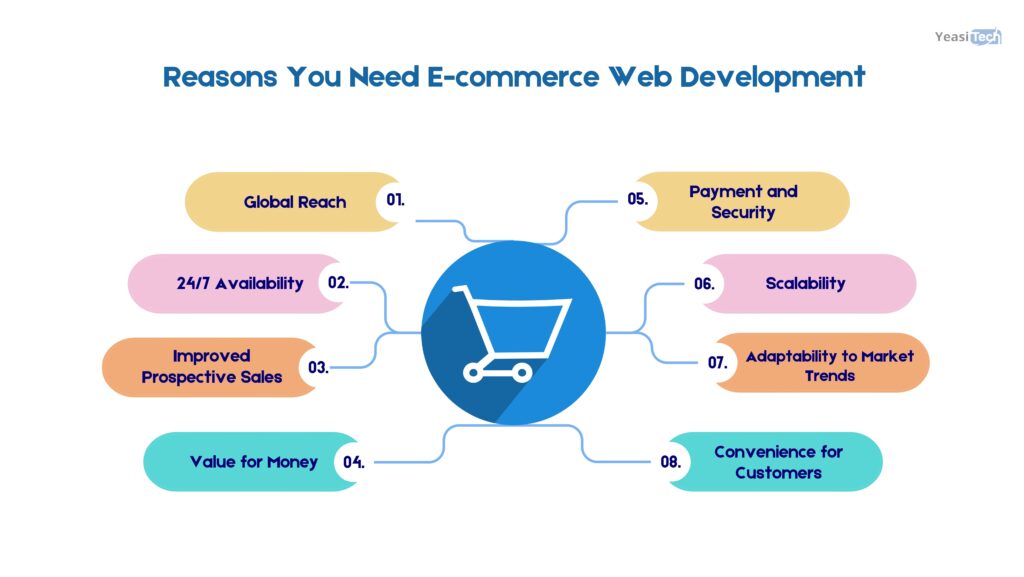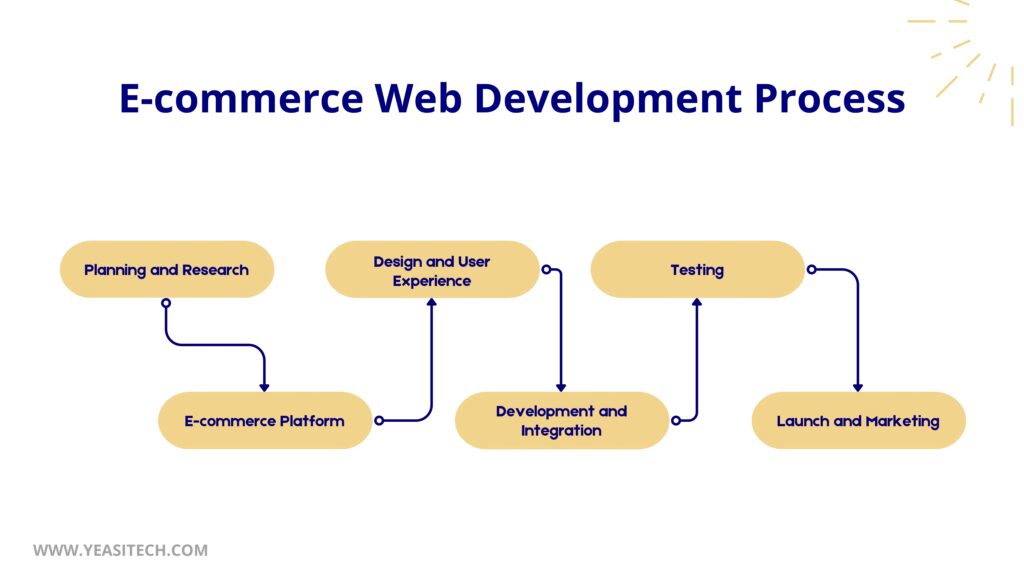One of the best platforms for earning money online is e-commerce web development. One of the many benefits of launching an e-commerce website is that it can reach a larger market and have fewer starting and operating costs. Moreover, creating an online business is simple, even for people without technological experience. All you need is a domain name, a platform, and a dependable eCommerce hosting service.
Table of Contents
The Need for E-commerce Web Development
If you’re still worried about selling online, remember that opening an eCommerce store gives you a lot of freedom. Internet stores are simpler and less expensive to start because they don’t need physical locations.
Let us look at the importance of e-commerce web development and other motivators to begin selling products online.
Reasons You Need E-commerce web development

For your business to achieve success, you must have an e-commerce website with secure payment processing, easy-to-use page navigation, and product discovery.
Here are some further reasons why your company needs e-commerce web development:
- 1. Global Reach: Businesses can reach a worldwide audience by using e-commerce platforms. With an online store, your products or services can be accessed by potential customers from around the world, breaking down geographical barriers.
- 2. 24/7 Availability: Unlike physical stores with fixed operating hours, e-commerce websites are open 24/7. Customers may purchase whenever they want because of this continuous availability, which boosts revenue and sales.
- 3. Improved Prospective Sales: An online presence can significantly boost a company’s sales potential. By offering an extra sales channel, e-commerce platforms help companies reach new markets and customers.
- 4. Value for Money: Compared to operating a physical store, setting up and managing an online store can save money. It eliminates the need for physical infrastructure, reduces labor requirements, and allows more effective inventory management.
- 5. Payment and Security: E-commerce platforms integrate secure online payment gateways, ensuring that transactions are safe and protected. Customers will feel more confident making purchases online as a result of this improved trust.
- 6. Scalability: The ability to grow with a business is a feature of e-commerce websites. The internet platform is easily upgraded and customizable to support more traffic and a larger product catalog as the firm expands.
- 7. Adaptability to Market Trends: E-commerce systems can change with the market with minimal effort. To adapt to changing client demands and market dynamics, businesses can update product information, alter prices, and put marketing strategies into action in real-time.
- 8. Convenience for Customers: Online shopping provides customers with an unmatched level of convenience. With mobile devices, they can shop while on the go or in the comfort of their own homes, exploring products and comparing prices.
The 6-step e-commerce web development process

It is not required, nor even advised, to start from scratch when creating an e-commerce website. You don’t need to be very technical or proficient in coding to start an online store because of a variety of platforms.
However, there are other things you must do before beginning the development process, along with choosing your platform. Before you jump right in, take into account the following:
1. Begin by making a plan
Making the choice to sell online is a major one. Also, until you understand the operating features, you are unable to take further action. Continue by understanding how it works. How come you want to sell things online? It’s simple to bring in more revenue. That being said, exactly how are you going to achieve it?
- Do you wish to increase online visitors in addition to your offline business ventures?
- Will you conduct direct-to-consumer sales through your e-commerce company?
- Should a firm grow from B2C to B2B or the other way around?
Consider e-commerce metrics when setting goals above your basic objectives.
- How many items do you intend to sell?
- How do you intend to increase the lifetime value of a customer?
- Do you intend to sell both domestically and abroad?
- How will you estimate the kind of growth you hope to see after the launch? For example, what is your target amount of weekly online sales?
2. Select a domain and a platform
Selecting a platform and domain for your e-commerce website comes next, when you have your plan in place. You should choose your domain name, or website URL, wisely. A brief, memorable domain name that reflects your brand is ideal.
Also, you have a variety of domain tools at your disposal, such as Dot-o-Mator, which assists you in selecting a domain name by suggesting options depending on the keywords you enter.
Another option is to create your website with an e-commerce platform’s help. E-commerce systems offer customizable options and assistance in creating a website from scratch that accurately reflects your brand. Squarespace, Shopify, and Wix are just a few of the options from which you can choose.
3. Define the desired shopping experience
What kind of online shopping experience would you like to provide to your clients? The following are just a few of the experiential elements you could want to think about:
- The capability of side-by-side product comparisons.
- Allowing your clients to quickly and simply select search results based on factors like price, size, or color.
- Providing a one-page checkout process that is optimized.
- Discounts, special offers, and various other types of promotions.
Consider whether your target market prefers to explore your website for long periods and find new things, or if they prefer a quick and easy purchase experience, as they do with needs like some consumer-packaged goods. Depending on your response, you may want to design your website for a distinct consumer path.
4. Include products
Ensure that adding and editing product listings is a simple process for you and that your inventory is synchronized with all of your sales channels. You might avoid overselling your products and streamline back-office procedures by doing this.
You must focus on the following points when adding products:
- Detailed product descriptions: Make sure to include all relevant information, including product specs, size information, etc., especially for products that went through extensive research.
- Exceptional product photos: Give your clients the assurance that they will receive exactly what they want when they place an order with you. It will not be that the products differ from the image you have put on your e-commerce website.
5. Install shipping and payment options
A website developer may help with the checkout and shopping cart processes, as well as with setting up shipping and integrating payment methods into your website. Usually, you’ll have a wide selection of payment gateways.
Customers are more willing to pay using a variety of payment options, such as buy now, pay later, but you don’t have to integrate them all. Payment gateways that support your target areas should also be selected if you’re selling internationally.
6. Launch website and do quality assurance
Make sure you’re satisfied with the e-commerce website’s design, functionality, and navigation after you’ve moved it from the stage to production by giving it a quick test run. The following is an in-depth check list:
- Make sure every item in the inventory is accurately listed.
- Go through the form titles and calls-to-action on the landing pages and homepage.
- Try out the checkout process.
- Check integrations for credit card, PayPal, Stripe, and other payment processing services twice.
- Verify that every image is optimized for load speed while maintaining great definition.
- Verify the functionality of all forms and links.
- Check out any product descriptions and categories that are lacking.
- Make sure all of your tax settings are accurate.
- Check your promo codes and vouchers.
It’s important to ensure that the website of your business looks great on desktop and mobile devices and that the user experience is the same everywhere.
What is the job of an e-commerce web developer?
Making a website’s design prototype come to life and perform as a website is the main duty of an e-commerce web developer. Provided differently, web development is the process of ensuring that a website’s design works as planned.
An e-commerce web developer would, for example, make sure that all hyperlinks, contact forms, calls to action (CTA) buttons, and navigational buttons work as they should.
What Is the Best Way to Select an E-Commerce Website Developer?
Next, we’ll examine the duties of an e-commerce developer and explain why it’s crucial that their expertise match your requirements for e-commerce web design. 73% of American customers agree that a brand’s customer experience matters most when making an online purchase, yet only 49% think that companies offer a positive experience, according to a PWC study.
Hiring an e-commerce web development company with experience in designing as well as building for e-commerce is the best way to guarantee that users on your site have an improved experience from them.
Recognize the strengths of various developers
Make sure you are aware of the developers’ strong points while considering them for your online store. Even though a few developers are skilled in both front-end and back-end programming, they usually choose to concentrate on one of them. Verify that the developer you select has the abilities you require. When developing your e-commerce website, keep the following important factors in mind:
- Categorization of products.
- Online security and PCI compliance.
- SEO
- number of gateways and payment choices.
- Integration of content management systems.
- Flexibility on mobile devices.
- Design of a shopping cart.
Choose based on what you need
Make sure you have a clear understanding of the features and capabilities you require from your e-commerce shop before selecting an e-commerce developer or development company.
A backend developer, for example, can be more important for your e-commerce solution if it makes use of an open-source framework than a designer, but you’ll probably need both.
If you’re using a SaaS platform, frontend work might be more important than anything else, but you might also require an API developer with experience. While an important number of apps with built-in links are available on most SaaS platforms, further complexity is best handled by a specialist.
Wrapping
The platforms that are available to you and your understanding of starting an e-commerce firm differ. At some point during your company’s lifecycle, you can discover that you require more web development assistance, regardless of whether you begin with an all-in-one solution or an expensive platform.
You’re ready to get started now that you understand the purpose of a web developer in your e-commerce launch and maintenance process, the features you should take into account while evaluating tech requirements, and the preparations you should make before launching.
What is web development for eCommerce?
E-commerce web development is the process of building and managing websites or online marketplaces that allow online purchases and sales of products and services.
Which technologies are frequently used in the development of e-commerce?
HTML, CSS, JavaScript, and well-known eCommerce systems like Magento, Shopify, and WooCommerce (for WordPress) are examples of common technologies. Custom solutions built with PHP, Python, or Node.js are also common.
Do I require both a backend and a frontend developer?
A backend developer may be more important than someone specializing in design services if your e-commerce solution makes use of an open source framework (though you’ll probably need both). You’ll likely require more frontend work than anything else if you’re using a SaaS platform, but you might also want someone with experience developing APIs.
Even if most SaaS systems offer a sizable selection of apps with pre-built links, it is recommended to leave extra complexity to the experts.
